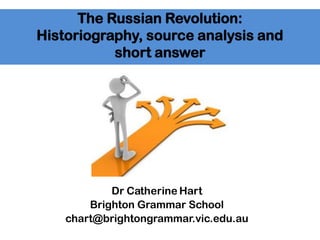
Hart htav pres july 26 2013
- 1. The Russian Revolution: Historiography, source analysis and short answer Dr Catherine Hart Brighton Grammar School chart@brightongrammar.vic.edu.au
- 2. There are THREE key resources you need to access in relation to this session: 1. This PPT (avail via Google Drive for immediate access and dropbox) 2. Hardcopy Booklet 3. Shared resource folder on Dropbox – email me to access (www.dropbox.com)
- 8. Short answer Revolution 1 Revolution 2 Section A: Two short answer questions (AOS 1) Section B: “Text” Analysis (AOS 1) Section A: “Text” Analysis (AOS 2) Section B: Essay (AOS 2)
- 9. What is historiography? What is it NOT? Why study historiography? Historiography History is a ‘living’ subject History is full of diversity Historians disagree http://alphahistory.com/vcehistory/about-historiography/
- 10. Historiography in Exam Revolution 1 Revolution 2 Section A: Two short answer questions (AOS 1) Section B: “Text” Analysis (AOS 1) Section A: “Text” Analysis (AOS 2) Section B: Essay (AOS 2) Section A Q3d Section B Q1d
- 11. Historiography • Start with historiography – definition and explanations • The key schools and their main arguments about the origins of the outbreak of Revolution (Booklet p11-16) • Significant historians within each period • Individual historians with their specific interpretations • See pp143-150 Study Design for main historians DISCUSSION: Which historians do you use? Why?
- 12. Historiography links http://alphahistory.com/russianrevolution/russian- revolution-historiography/ Orlando Figes Sheila Fitzpatrick Richard Pipes John Reed Robert Service Adam Ulam Dmitri Volkogonov See Booklet
- 13. Great links • http://mcvcehistory.wikispaces.com/Unit+4+R evolutions+Russia • http://mcvcehistory.wikispaces.com/Unit+4+R evolutions+Russia • http://alphahistory.com/russianrevolution/rus sian-revolution-historiography/
- 14. Old regime images often show the inequity (above) and the corruption (right) of the tsarist regime. More idealist images show the determined strength of the working people (left) Old Regime
- 15. Old Regime Many images focus on the short-comings and the poor political leadership of the tsar including the Russo- Japanese War (top) or his pogroms against Jews (right)
- 16. Bolshevik images Bolshevik images are often idealistic about the new society, portraying their leaders and the proletariat as giants or kindly paternalists
- 17. "Lenin proclaims Soviet power" by Vladimir Serov, 1947
- 18. The Russian Tsars at home (1916)
- 19. Source analysis scaffolds COMA – content, origin, motivation, audience OPVL – origin, purpose, value, limitations Describe-Identify-Interpret-Evaluate-Reflect See booklet p23 DISCUSSION: What scaffold/s do you use? Why?
- 20. Teaching strategies for visual analysis: Cartoon PD in a package http://john.curtin.edu.au/education/cartoonpd/
- 26. Ok, but what about written sources? Summarising Contextualising Inferring Monitoring Corroborating http://www.historicalinquiry.com/scim/index.cfm
- 27. See booklet pages 24-34 Short answer in exam Revolution 1 Revolution 2 Section A: Two short answer questions (AOS 1) Section B: “Text” Analysis (AOS 1) Section A: “Text” Analysis (AOS 2) Section B: Essay (AOS 2) Section A Q1 & 2 DISCUSSION: How do you support development of students’ short answer responses?
- 28. Two things… Scholarships to Jerusalem (Holocaust studies) Applications for Pauline Glass Study Grants close Tuesday, 6 August 2013 – see Courage to Care stand TODAY
- 29. Exit card 1 new idea 1 question 1 thing you’ll try